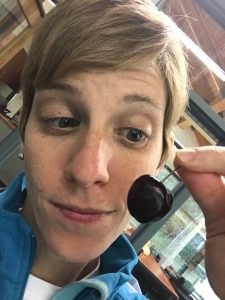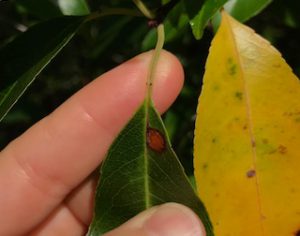We are probably all familiar with cherries, the fruit we get to enjoy this time of year. But today I want to talk about the cherry trees we have here in Florida, which unfortunately aren’t the same ones that produce the yummy cherries we eat. Those are Prunus avium which are native to Europe and Asia and are now cultivated in the U.S. Two specifically that I want to discuss are the black cherry (Prunus serotina) and Carolina laurel cherry or cherry-laurel (Prunus caroliniana).

You probably already observed they are in the same genus and thus the same family, the Rosaceae. This family (the Rose family) is super important; it’s responsible for many of the fruits we know and love including: apples, almonds, pears, raspberries, strawberries, and of course cherries. As with a lot of trees in the same genus, it can often be difficult to tell species apart from one another. So, how to tell black cherry from cherry-laurel?
Leaves

To start, black cherries are deciduous and cherry-laurels are not. This can be helpful for identify these species in winter or even fall as black cherry leaves begin to turn yellow and pinkish red. If you’re looking at a leaf and you’re pretty sure it’s a cherry of some sort, but aren’t sure which one, be sure to check out the leaf margins or edges of the leaf. The leaf margins of black cherry are finely toothed whereas the leaf margins of cherry-laurel are mostly entire (smooth), but occasionally are lined with fine bristle tips. Also, if you rub the leaf of a cherry-laurel you will be left with an aroma that is lacking in the leaves of black cherry. Another neat trick is to look for these secret glands that black cherry leaves have on their petiole or leafstalk.

Look closely and you will see two glandular dots. And while you’re looking closely at the leaf you can note dense hairs along the midrib on the underside of a black cherry leaf. Cherry-laurel leaves lack glands and hairs.
Height
If you have leaves in-hand that should do the trick, but if not you can look up. We often have to look up when it comes to trees, but when it comes to cherry trees, really, look up! If you’re looking at a mature tree, sometimes size alone can be helpful in identification. Black cherry trees grow to twice the size of cherry-laurels. We are talking 80 feet versus 40 feet.
Bark
Bark is always there, but varies significantly when looking at bark on a young tree versus a mature tree. Note the differences here between the young black cherry bark (left) and the young cherry-laurel bark (right). Photo Credit: Will Cook, http://www.carolinanature.com/trees/prse.html and http://www.carolinanature.com/trees/prca.html
Bark might sound boring (unless you’re talking about chocolate bark) but the cool thing about bark is IT’S ALWAYS THERE! Unlike leaves, we can always count on bark to help with tree identification. The tricky thing with cherry bark is it’s quite different on a young tree versus an older, mature tree.
Let’s start with young trees first. The bark of a young black cherry tree is very thin and smooth with distinct, lighter colored lenticels (pores) that contrast with the darker, reddish brown bark. Bark of young cherry-laurel is also thin and smooth, but gray in color with less obvious lenticels.
Mature bark is quite different. As black cherry bark matures, it starts to split and crack forming distinct, thin, flaky plates of gray bark, and is also aromatic. The underlying reddish brown bark will remain visible until covered completely by these bark plates. Cherry-laurel bark will also become more fissured and scaly, turning a darker gray.

So leaves are probably your best bet here, but the bark (at least when young) can help be helpful for identification. One other thing to note is that the fruit of cherry-laurel will often persist into the growing season, which is not the case with black cherry. So, if you see fruit in the spring that might also be a sign it’s a cherry-laurel. While you’re there check out the underside of the leaf for a glandular dot or use your nose to see if you smell an aroma from the leaf.
There you have it. Black cherry versus cherry-laurel.
Happy Learning!
If you enjoyed this series and would like to read more about commonly confused plants and animals in Florida, you can find more here:
https://blogs.ifas.ufl.edu/global/tag/commonly-confused/
 6
6

